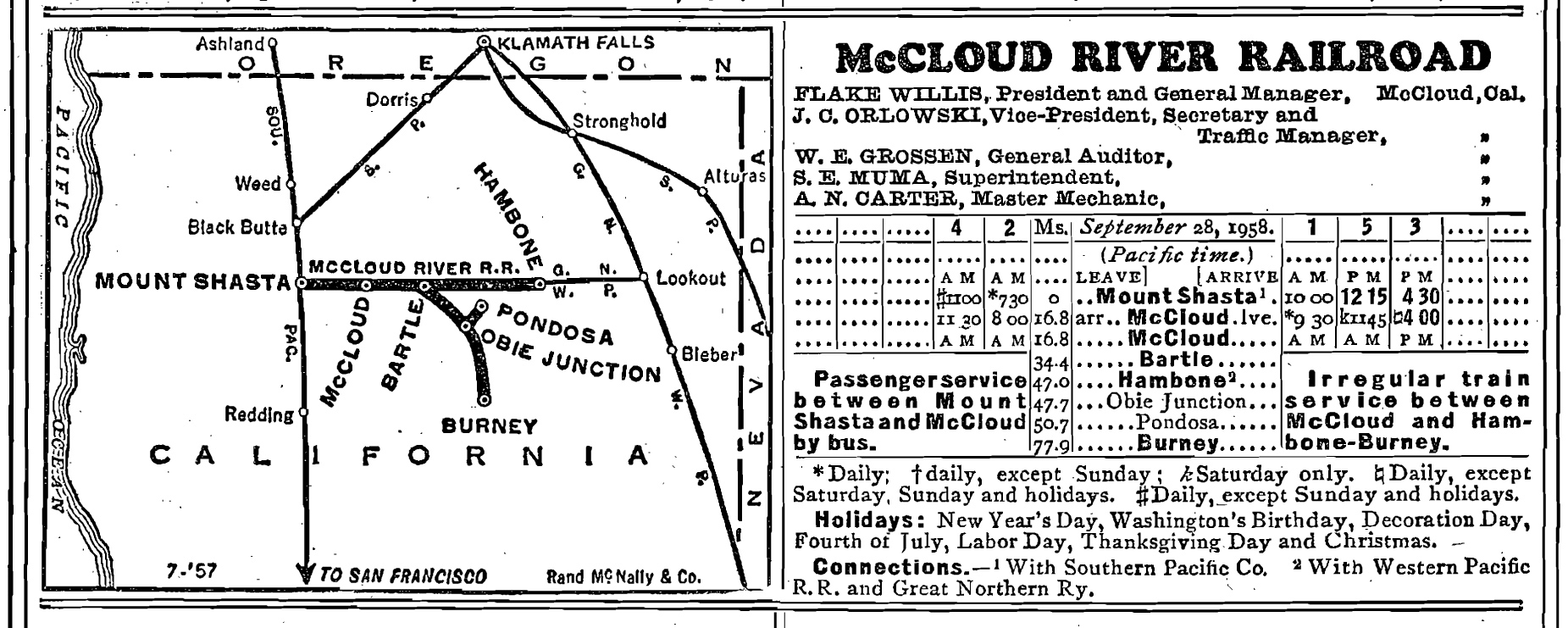McCloud River Railroad: Serving The Timber Industry (1897-2009)
Last revised: September 4, 2024
By: Adam Burns
Most often railroads like the Southern Pacific, Santa Fe,
and interurban Pacific Electric Railway are regarded as California's
best remembered such companies.
However, another sometimes forgotten legendary system was the McCloud River Railroad (reporting marks, MCR), a logging line operating in the state's timber rich northern region.
It was established in 1897 by lumber mill interests who were looking to move their finished product as quickly as possible to market and with a nearby connection to the much larger Central Pacific (then an SP subsidiary), a railroad seemed quite logical.
During the railroad's peak years it owned a system stretching nearly 100 miles and while it was built to move timber and it also operated as a standard common carrier shipping whatever freight was available (and for more than 50 years also dispatched passenger trains).
As timber demand declined the railroad slowly cut back although new ownership also led to its downfall. It closed in 2009 and the property is now for sale as a rail/trail as of 2012.
Photos
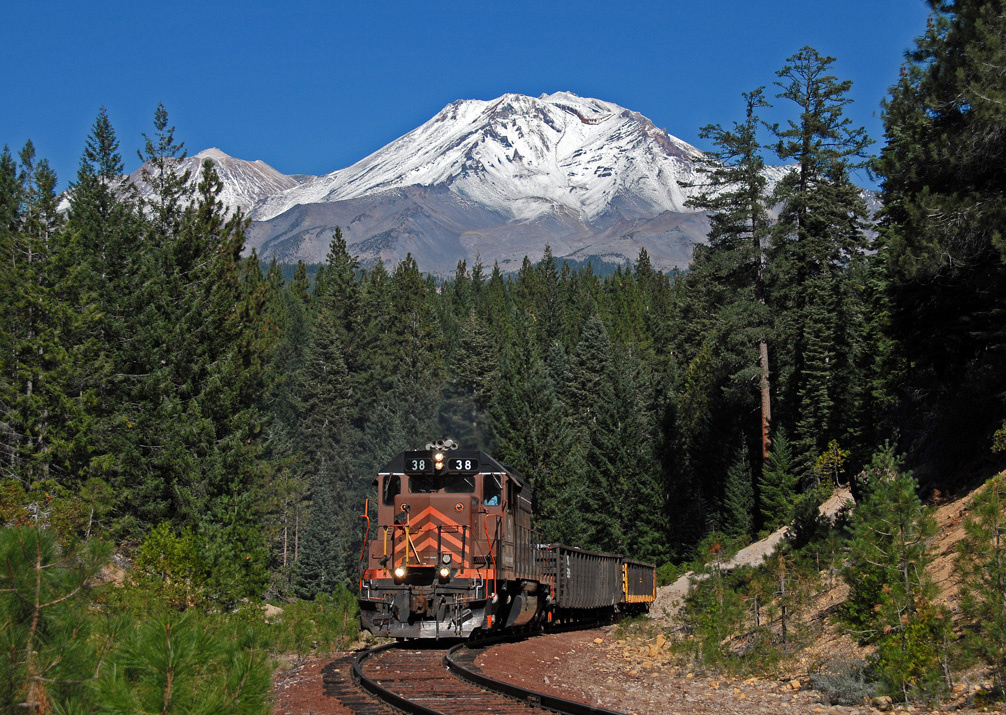 McCloud SD38 #38 has a short train of gondolas filled with scrap metal near Big Canyon on October 13, 2008. In the background is the majestic Mt. Shasta. Drew Jacksich photo.
McCloud SD38 #38 has a short train of gondolas filled with scrap metal near Big Canyon on October 13, 2008. In the background is the majestic Mt. Shasta. Drew Jacksich photo.History
During the second half of the 19th century and particularly with the completion of the Transcontinental Railroad in the spring of 1869 California began booming.
With a demand for construction and materials and the rich timber regions located to the state's north it was not long until companies began moving in.
One such business was owned by George Scott and William Van Arsdale. By the 1890s they already were operating sawmills on the western slope of Mount Shasta with connections to the CP/SP whose main line to Oregon passed through the area.
However, there were no more locations here to continue expansion so they looked east on the other side of the mountain. With no direct rail service, however, any mills they built would also need a new railroad.
In 1896 they purchased a bankrupt mill from Friday George in the area and converted a former streetcar/interurban line into a heavy freight railroad.
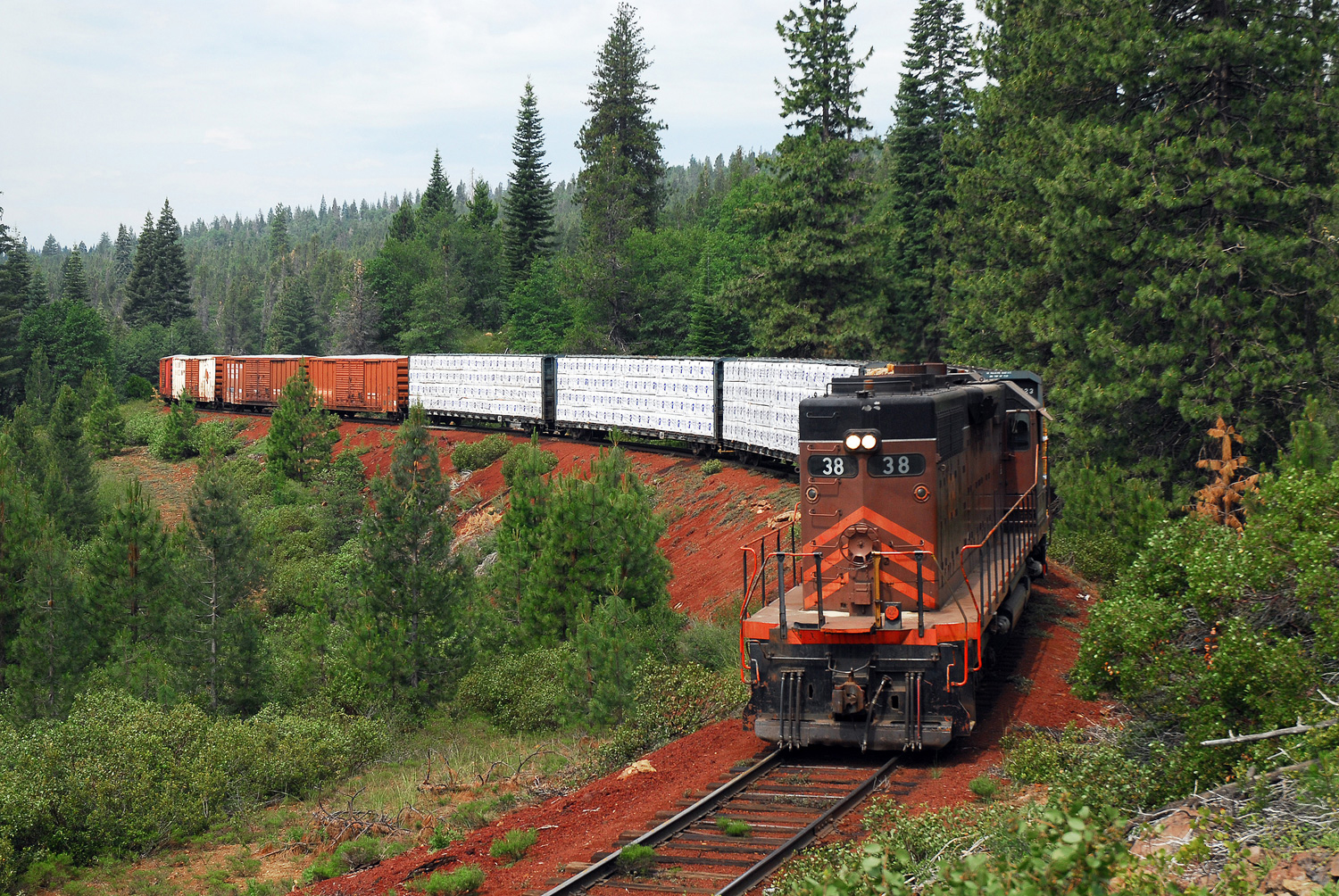 McCloud Railway SD38 #38 arrives at Signal Butte, California with loads on June 28, 2006. Drew Jacksich photo.
McCloud Railway SD38 #38 arrives at Signal Butte, California with loads on June 28, 2006. Drew Jacksich photo.By late 1896 about four miles of track was opened and a connection at the town of Mt. Shasta with the CP.
On January 21, 1897 the McCloud River Railroad Company and the McCloud River Lumber Company were formed, both operated and owned by the same individuals.
Interestingly, Van Arsdale and Scott stuck around only long enough to see the operation during its earliest years as they sold their interests in 1902.
By 1905 the railroad was completed to McCloud and continued to expand eastward, further into rich timber reserves.
By 1920 the system had expanded beyond Bartle and its main line now stretched more than 35 miles. Additionally, as with most logging lines it was also building miles of temporary spurs to tap various tracts of pine timber.
These short branches were shoddily built and were only meant to be used briefly before being torn out and the track re-laid elsewhere.
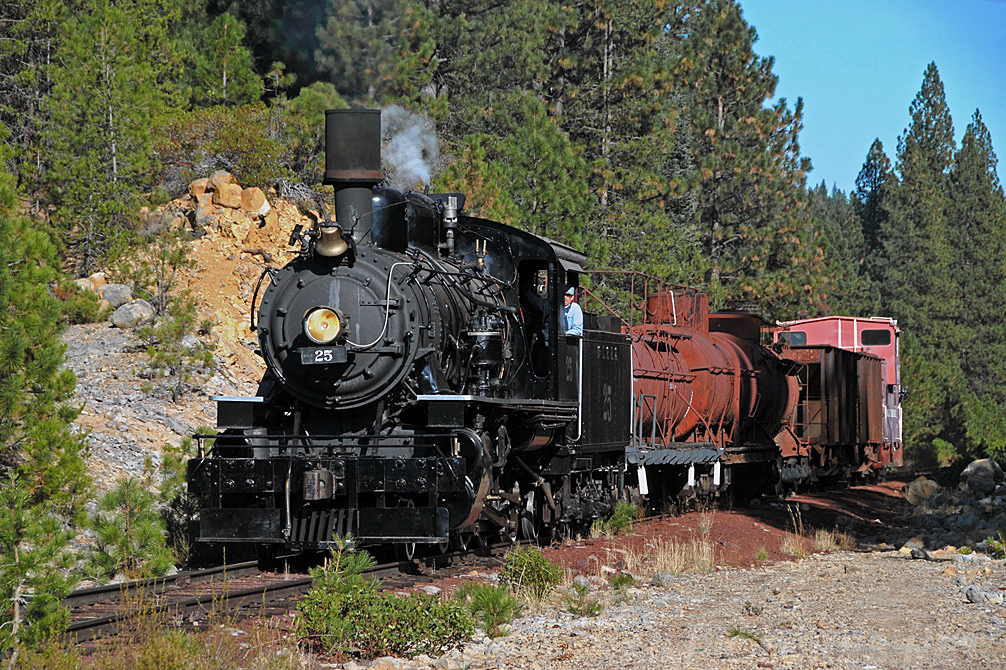 McCloud 2-6-2 Prairie #25 pulls a photo freight westbound near Kinyon, California and towards McCloud on October 11, 2008. The author notes that this section of the railroad has since been pulled up. Drew Jacksich photo.
McCloud 2-6-2 Prairie #25 pulls a photo freight westbound near Kinyon, California and towards McCloud on October 11, 2008. The author notes that this section of the railroad has since been pulled up. Drew Jacksich photo.From a corporate standpoint, the McCloud River Lumber Company divested itself of the railroad in 1917 to avoid any antitrust issues with all of shares handed over to the shareholders.
The system continued to march westward after 1920. It reached more timber via a branch to the recently created town of Pondosa and the biggest feat to occur during that decade was a connection to another major Class I, the Great Northern at Hambone.
The GN had recently completed its "Inside Gateway" project with the Western Pacific where both lines established a connection with one another at Bieber, California.
Being so close to the McCloud River and its heavy timber/lumber traffic, GN constructed an extension from Lookout (just north of Bieber) to reach Hambone (the WP would also have trackage rights over this branch, which essentially gave the McCloud River Railroad yet another major interchange partner).
System Map
At this point the MCRR operated exactly 47.0 miles of track from Mt. Shasta to Hambone, which did not include all logging spurs and general sidings.
During the 1940s and 1950s the railroad grew for the final time. It took over a former roadbed south of Bartle once used by Pacific Gas & Electric and by 1955 had reached Burney with a branch to Sierra.
It also shifted its route to Pondosa using this line and abandoned the other branch reaching the small town.
The McCloud River Railroad's new line south of Bartle was thanks to a new customer, the Fruit Growers Supply that needed wooden shipping crates to move its produce. Unfortunately, 1963 spelled not only the end of the MCRR's growth but also signaled the beginning of its decline.
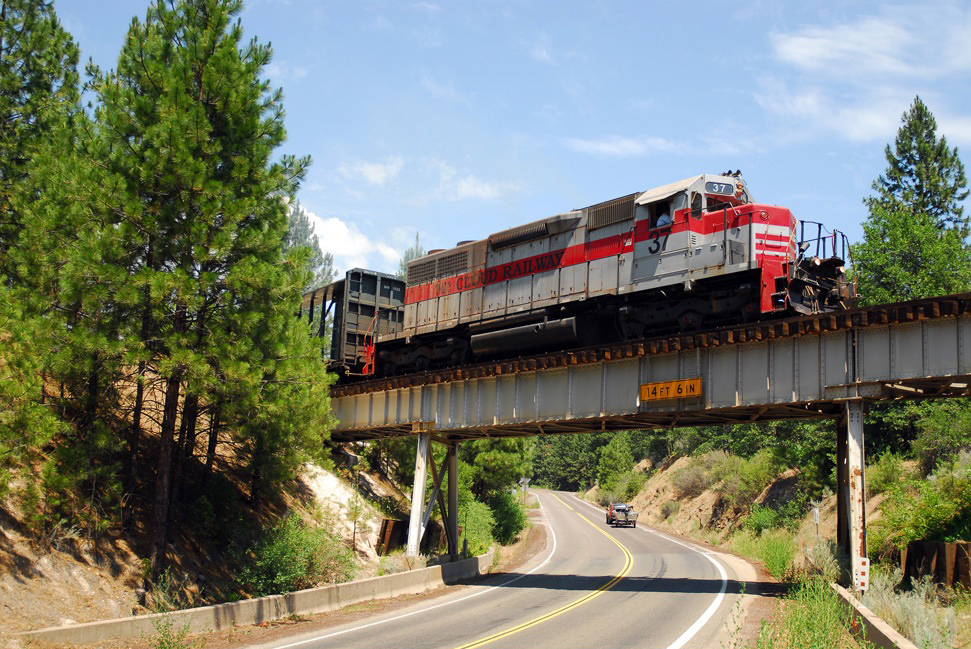 McCloud Railway SD38 #37 crosses Highway 89 just north of Lake Britton, California on its way to the Sierra Pacific Mill in Burney on June 26, 2006. Drew Jacksich photo.
McCloud Railway SD38 #37 crosses Highway 89 just north of Lake Britton, California on its way to the Sierra Pacific Mill in Burney on June 26, 2006. Drew Jacksich photo.Final Years
That year it was acquired by US Plywood and since it was no longer locally owned, the national wood products company began severely cutting back operations.
It ended nearly all rail timber rail movements, shifting these to trucks. As such, nearly its only remaining traffic became finished products such as plywood and lumber from mills at McCloud, Pondosa, and Scott.
In 1969 the line was sold again to U.S. Plywood-Champion Papers, and two times in the 1970s, Champion International in 1972 and Itel Corporation in 1977.
During this time, however, the railroad still operated much of its original system that spanned 77.9 main line miles between Mt. Shasta, Hambone, and Burney.
On July 1, 1992 it was sold for a final time to 4-Rails, Inc. owned by Jeff and Verline Forbis who renamed the company as the McCloud Railway.
It was also during the 1990s that the MCRR fell on hard times. It lost its interchange and Hambone, losing paper traffic. By 2005 it only operated about 16.8 miles of main line between Mt. Shasta and McCloud, despite the fact that shippers remained east of McCloud.
The final hammer fell in 2009 when the entire property was shuttered, even the once popular Shasta Sunset Dinner Train that had been operating the route to McCloud for a number of years.
In early April, 2012 it was announced that the entire property was looking to be sold to a non-profit group and turned into a rail/trail.
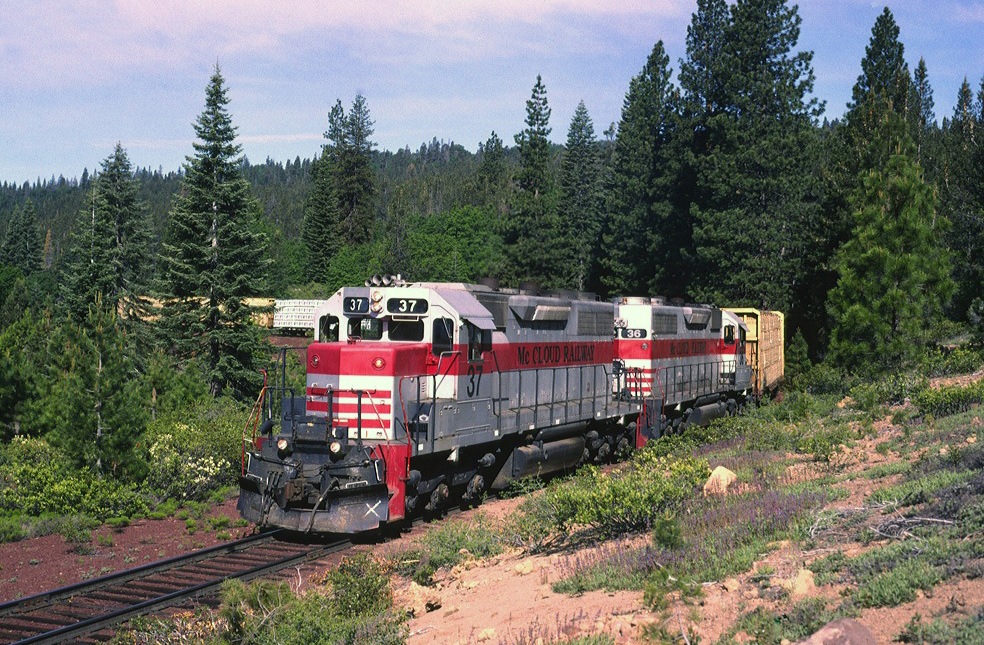 A pair of McCloud SD38s, #37 and #36, have a freight of wood products at the Signal Butte switchback during June of 2005. The author notes the six-axle EMDs will shove the train backward, uphill to the Union Pacific interchange at Mt. Shasta. Drew Jacksich photo.
A pair of McCloud SD38s, #37 and #36, have a freight of wood products at the Signal Butte switchback during June of 2005. The author notes the six-axle EMDs will shove the train backward, uphill to the Union Pacific interchange at Mt. Shasta. Drew Jacksich photo.Motive Power
Over the years the McCloud River Railroad had used several types of motive power:
- During the steam era this included a mixture of models from Shays to an 0-6-6-0T Mallet built by Baldwin although most of its fleet consisted of 2-6-2 Prairies and 2-8-2 Mikados.
- The diesel era was even more interesting as the company loved Baldwins using everything from DRS6-6-1500s to AS616s and RS12s.
During its final years the MCRR relied on SD38s and an SD38-2. For an excellent, in-depth history on the McCloud River Railroad please click here to visit a site that discusses everything from its history to motive power roster.
Recent Articles
-
Arizona's - Wine Tasting - Train Rides
Jan 14, 26 02:04 PM
For those who want to experience the charm of Arizona's wine scene while embracing the romance of rail travel, wine tasting train rides offer a memorable journey through the state's picturesque landsc… -
Arkansas's - Wine Tasting - Train Rides
Jan 14, 26 01:57 PM
This article takes you through the experience of wine tasting train rides in Arkansas, highlighting their offerings, routes, and the delightful blend of history, scenery, and flavor that makes them so… -
Tennessee ~ Murder Mystery ~ Dinner Train Rides
Jan 14, 26 01:42 PM
Amidst the rolling hills and scenic landscapes of Tennessee, an exhilarating and interactive experience awaits those with a taste for mystery and intrigue. -
California ~ Murder Mystery ~ Dinner Train Rides
Jan 14, 26 01:26 PM
When it comes to experiencing the allure of crime-solving sprinkled with delicious dining, California's murder mystery dinner train rides have carved a niche for themselves among both locals and touri… -
Illinois ~ Murder Mystery ~ Dinner Train Rides
Jan 14, 26 01:13 PM
Among Illinois's scenic train rides, one of the most unique and captivating experiences is the murder mystery excursion. -
Vermont's - Murder Mystery - Dinner Train Rides
Jan 14, 26 12:57 PM
There are currently murder mystery dinner trains offered in Vermont but until recently the Champlain Valley Dinner Train offered such a trip! -
Massachusetts Dinner Train Rides On Cape Cod!
Jan 14, 26 12:20 PM
The Cape Cod Central Railroad (CCCR) has carved out a special niche by pairing classic New England scenery with old-school hospitality, including some of the best-known dining train experiences in the… -
Maine Dinner Train Rides In Portland!
Jan 14, 26 11:31 AM
While this isn’t generally a “dinner train” railroad in the traditional sense—no multi-course meal served en route—Maine Narrow Gauge does offer several popular ride experiences where food and drink a… -
Kentucky Dinner Train Rides In Bardstown!
Jan 13, 26 01:14 PM
The essence of My Old Kentucky Dinner Train is part restaurant, part scenic excursion, and part living piece of Kentucky rail history. -
Kansas Dinner Train Rides In Abilene!
Jan 13, 26 12:44 PM
If you’re looking for a heritage railroad that feels authentically Kansas—equal parts prairie scenery, small-town history, and hands-on railroading—the Abilene & Smoky Valley Railroad (A&SV) delivers. -
Michigan ~ Murder Mystery ~ Dinner Train Rides
Jan 13, 26 11:24 AM
Among the lesser-known treasures of this state are the intriguing murder mystery dinner train rides—a perfect blend of suspense, dining, and scenic exploration. -
Virginia's - Murder Mystery - Dinner Train Rides
Jan 13, 26 11:11 AM
Among the state's railroad attractions, murder mystery dinner trains stand out as a captivating fusion of theatrical entertainment, fine dining, and scenic travel. -
Arizona Dinner Train Rides At The Grand Canyon!
Jan 13, 26 10:59 AM
While the Grand Canyon Railway does not offer a true, onboard dinner train experience it does offer several upscale options and off-train dining. -
Georgia Dinner Train Rides In Nashville!
Jan 13, 26 10:27 AM
If you’ve ever wished you could slow down, trade traffic for jointed rail, and let a small-town landscape roll by your window while a hot meal is served at your table, the Azalea Sprinter delivers tha… -
Indiana Valentine's Train Rides
Jan 12, 26 04:27 PM
If you’ve ever wished you could step into a time when passenger trains were a Saturday-night treat and a whistle echoing across farm fields meant “adventure,” the Nickel Plate Express delivers that fe… -
Ohio Valentine's Train Rides!
Jan 12, 26 04:20 PM
The Hocking Valley Scenic Railway offers one of the region’s most atmospheric ways to experience the Hocking Hills area: from the rhythmic click of jointed rail to the glow of vintage coaches rolling… -
Wisconsin's - Wine Tasting - Train Rides
Jan 12, 26 03:10 PM
Wisconsin might not be the first state that comes to mind when one thinks of wine, but this scenic region is increasingly gaining recognition for its unique offerings in viticulture. -
California's - Wine Tasting - Train Rides
Jan 12, 26 02:34 PM
This article explores the charm, routes, and offerings of these unique wine tasting trains that traverse California’s picturesque landscapes. -
Wisconsin Scenic Train Rides In North Freedom!
Jan 12, 26 02:20 PM
The Mid-Continent Railway Museum is a living-history museum built around the sights, sounds, and everyday rhythms of small-town and shortline railroading in the early 20th century, what the museum cal… -
Vermont Scenic Train Rides In Burlington!
Jan 12, 26 01:18 PM
Today, GMRC is best known by many travelers for its Burlington-based passenger experiences—most famously the Champlain Valley Dinner Train and the sleek, limited-capacity Cocktails on the Rails. -
Maryland's - Murder Mystery - Dinner Train Rides
Jan 12, 26 01:03 PM
Maryland is known for its scenic landscapes, historical landmarks, and vibrant culture, but did you know that it’s also home to some of the most thrilling murder mystery dinner trains? -
Minnesota's - Murder Mystery - Dinner Train Rides
Jan 12, 26 12:17 PM
Murder mystery dinner trains offer an enticing blend of suspense, culinary delight, and perpetual motion, where passengers become both detectives and dining companions on an unforgettable journey. -
Vermont Dinner Train Rides In Burlington!
Jan 12, 26 12:09 PM
There is one location in Vermont hosting a dedicated dinner train experience at the Green Mountain Railroad. -
Connecticut Dinner Train Rides In Essex!
Jan 12, 26 10:39 AM
Connecticut's rail heritage can be traced back to the industry's earliest days and a few organizations preserve this rich history by offering train rides. The Essex Steam Train also hosts dinner-theme… -
Florida Scenic Train Rides In Parrish!
Jan 11, 26 10:26 PM
The Florida Railroad Museum (FRRM) in Parrish offers something increasingly rare in today’s rail landscape: a chance to ride historic equipment over a surviving fragment of an early-20th-century mainl… -
California's - Wine Tasting - Train Rides
Jan 11, 26 02:28 PM
This article explores the charm, routes, and offerings of these unique wine tasting trains that traverse California’s picturesque landscapes. -
Georgia's - Murder Mystery - Dinner Train Rides
Jan 11, 26 02:07 PM
In the heart of the Peach State, a unique form of entertainment combines the thrill of a murder mystery with the charm of a historic train ride. -
Colorado ~ Murder Mystery ~ Dinner Train Rides
Jan 11, 26 01:43 PM
Nestled among the breathtaking vistas and rugged terrains of Colorado lies a unique fusion of theater, gastronomy, and travel—a murder mystery dinner train ride. -
Minnesota Dinner Train Rides In Duluth!
Jan 11, 26 01:32 PM
One of the best ways to feel the region's history in motion today is aboard the North Shore Scenic Railroad (NSSR), which operates out of Duluth’s historic depot. -
Illinois Dinner Train Rides At Monticello!
Jan 11, 26 12:42 PM
The Monticello Railway Museum (MRM) is one of those places that quietly does a lot: it preserves a sizable collection, maintains its own operating railroad, and—most importantly for visitors—puts hist… -
Alabama's - Wine Tasting - Train Rides
Jan 10, 26 09:29 AM
While the state might not be the first to come to mind when one thinks of wine or train travel, the unique concept of wine tasting trains adds a refreshing twist to the Alabama tourism scene. -
Maryland Dinner Train Rides At WMSR!
Jan 10, 26 09:13 AM
The Western Maryland Scenic Railroad (WMSR) has become one of the Mid-Atlantic’s signature heritage operations—equal parts mountain railroad, living museum, and “special-occasion” night out. -
Arkansas Dinner Train Rides On The A&M!
Jan 10, 26 09:11 AM
If you want a railroad experience that feels equal parts “working short line” and “time machine,” the Arkansas & Missouri Railroad (A&M) delivers in a way few modern operations can. -
South Dakota's - Murder Mystery - Dinner Train Rides
Jan 10, 26 09:08 AM
While the state currently does not offer any murder mystery dinner train rides, the popular "1880 Train" at the Black Hills Central recently hosted these popular trips! -
Wisconsin's - Murder Mystery - Dinner Train Rides
Jan 10, 26 09:07 AM
Whether you're a fan of mystery novels or simply relish a night of theatrical entertainment, Wisconsin's murder mystery dinner trains promise an unforgettable adventure. -
Missouri's - Murder Mystery - Dinner Train Rides
Jan 10, 26 09:05 AM
Missouri, with its rich history and scenic landscapes, is home to one location hosting these unique excursion experiences. -
Washington ~ Murder Mystery ~ Dinner Train Rides
Jan 10, 26 09:04 AM
This article delves into what makes murder mystery dinner train rides in Washington State such a captivating experience. -
Kentucky Scenic Train Rides At KRM!
Jan 09, 26 11:13 PM
Located in the small town of New Haven the Kentucky Railway Museum offers a combination of historic equipment and popular excursions. -
Washington "Wine Tasting" Train Rides
Jan 09, 26 08:53 PM
Here’s a detailed look at where and how to ride, what to expect, and practical tips to make the most of wine tasting by rail in Washington. -
Kentucky's - Wine Tasting - Train Rides
Jan 09, 26 08:21 PM
Kentucky, often celebrated for its rolling pastures, thoroughbred horses, and bourbon legacy, has been cultivating another gem in its storied landscapes; enjoying wine by rail. -
Kentucky's - Murder Mystery - Dinner Train Rides
Jan 09, 26 01:12 PM
In the realm of unique travel experiences, Kentucky offers an enchanting twist that entices both locals and tourists alike: murder mystery dinner train rides. -
Utah's - Murder Mystery - Dinner Train Rides
Jan 09, 26 01:05 PM
This article highlights the murder mystery dinner trains currently avaliable in the state of Utah! -
North Carolina Dinner Train Rides At NCTM!
Jan 09, 26 12:51 PM
Tucked into the Piedmont town of Spencer, the North Carolina Transportation Museum is the kind of place that feels less like a typical museum and more like a living rail yard that never quite stopped… -
Tennessee Dinner Train Rides At The TVRM!
Jan 09, 26 12:39 PM
Tucked into East Chattanooga, the Tennessee Valley Railroad Museum (TVRM) is less a “museum you walk through” and more a railroad you step aboard. -
New York Scenic Train Rides On The A&A!
Jan 09, 26 11:20 AM
The A&A is both a common-carrier short line moving freight and a heritage railroad hosting popular excursion trains, all on the same storied right-of-way. -
Pennsylvania Scenic Train Rides In Hollidaysburg!
Jan 09, 26 11:14 AM
Tucked into the Juniata River valley just south of Altoona, the Everett Railroad offers one of the most approachable—and photogenic—heritage-rail experiences in Pennsylvania -
Montana Dinner Train Rides Near Lewistown!
Jan 08, 26 03:03 PM
The Charlie Russell Chew Choo turns an ordinary rail trip into an evening event: scenery, storytelling, live entertainment, and a hearty dinner served as the train rumbles across trestles and into a t… -
Alabama's - Murder Mystery - Dinner Train Rides
Jan 08, 26 02:19 PM
There is currently one location in the state offering a murder mystery dinner experience, the Wales West Light Railway! -
Rhode Island's - Murder Mystery - Dinner Train Rides
Jan 08, 26 01:43 PM
Let's dive into the enigmatic world of murder mystery dinner train rides in Rhode Island, where each journey promises excitement, laughter, and a challenge for your inner detective. -
Florida's - Wine Tasting - Train Rides
Jan 08, 26 01:13 PM
Wine by train not only showcases the beauty of Florida's lesser-known regions but also celebrate the growing importance of local wineries and vineyards.

